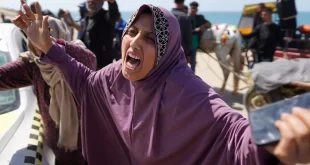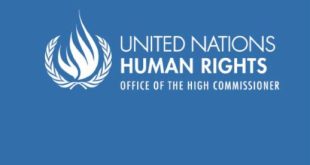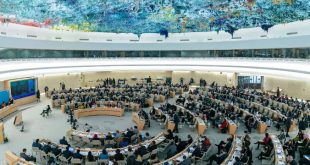Up to 26 people are reported to have been killed after one of the strongest earthquakes ever recorded struck Japan, triggering a 10-metre-high tsunami along parts of the country's northeastern coastline.
The massive 8.9-magnitude earthquake struck Japan on Friday, sweeping away cars, boats, homes and people as widespread fires burned out of control.
Japan's NHK television reported many injuries and showed pictures of major tsunami damage in the north, with buildings being inundated by waves of water in Onahama city in Fukushima prefecture.
The country's meteorological agency said 26 people had been confirmed dead in the aftermath of the quake and tsunami, and 44 fires had broken out across the country.
The death toll included three people who were reportedly crushed to death when their houses collapsed in Ibaraki prefecture, northeast of the capital, Tokyo.
News of the deaths came amid a warning that another strong quake could be imminent on the northeast Honshu island, Japan's main island.
 Prime minister's address
Prime minister's address
Japan's prime minister addressed the nation after the quake, saying major damage had been done but that help is on the way.
In a televised address on Friday, Naoto Kan said the government was making "every effort possible" to minimise damage."The earthquake has caused major damage in broad areas in northern Japan," he said. "Some of the nuclear power plants in the region have automatically shut down, but there is no leakage of radioactive materials to the environment."
His words came amid the issuing of a tsunami warning for much of the Pacific region, following a wave set off by the Japan quake that is currently higher than some Pacific islands, the International Federation of Red Cross and Red Crescent Societies said.
"Our biggest concern is the Asia and Pacific region, where developing countries are far more vulnerable to this type of
unfolding disaster. The tsunami is a major threat," Paul Conneally, spokesman for the federation, the world's biggest
disaster relief network, told the Reuters news agency in Geneva.
"At the moment, it is higher than some islands and could go right over them," he said.
Houses washed away
Shortly after the quake struck, a 10-metre tsunami hit Sendai airport in the north-east. Television footage showed people standing on the roof of the terminal building.
The tsunami roared over embankments in Sendai city, washing cars, houses and farm equipment inland before reversing directions and carrying them out to sea. Flames shot from some of the houses, probably because of burst gas pipes.
|
The Pacific Tsunami Warning Centre in Hawaii has widened its tsunami warning to cover most of the Pacific Ocean, including Russia, the Philippines, Papua New Guinea, Hawaii, Australia, New Zealand and the Pacific coast of South America. "An earthquake of this size has the potential to generate a destructive tsunami that can strike coastlines near the epicentre within minutes and more distant coastlines within hours," the centre said in a statement. It did not include North America in the warning but the Tsunami Warning Centre in Alaska issued a tsunami watch for the entire western coast of the United States and Canada from the Mexican border to Chignik Bay in Alaska. Al Jazeera's Marga Ortigas, reporting from Manila in the Philippines, said the military there had been ordered to help evacuate areas at risk on the east coast. High alert Meanwhile, a huge fire engulfed an oil refinery in Iichihara near Tokyo, where four million homes were said to be without electricity. Plumes of smoke rose from at least 10 locations in city. Military airplanes were flying over the worst-affected areas to assess the need for rescue efforts and 30 international search and rescue teams were prepared to go to Japan to provide assistance following the quake, the United Nations said. Yukiko Shimahara, a Japanese journalist, told Al Jazeera that the airports and trains in Tokyo have been shut down following the quake. The quake that struck at 2:46pm was followed by a series of powerful aftershocks, including a 7.4-magnitude one about 30 minutes later. Al Jazeera's Melissa Chan, reporting from Beijing, said tremors were felt as far away as the Chinese capital. Several earthquakes have hit the region in recent days, including a 7.2-magnitude quake on Wednesday. "Japan has been on high alert since the earthquake on Wednesday," Al Jazeera's Harry Fawcett, following developments from the Malaysian capital, Kuala Lumpur, said. "Japan is very well equipped to deal both with the initial tremors caused by an earthquake: buildings are systematically built with allowances for sway so that they are less likely to fall down. Also coastal cities have long had tsunami protection measures in place." Friday's quake struck at a depth of 24 kilometres, about 125 kilometres off the eastern coast, the country's meteorological agency said. The quake's magnitude surpasses the 7.9 Great Kanto quake of 1923, which killed more than 140,000 people in the Tokyo area. Japan lies on the "Ring of Fire"- an arc of earthquake and volcanic zones that stretches around the Pacific Rim and where about 90 per cent of the world's quakes occur. |
|
Source:
Al Jazeera and agencies
|
 Sri lanka Muslims Web Portal Diversity and Inclusiveness
Sri lanka Muslims Web Portal Diversity and Inclusiveness




